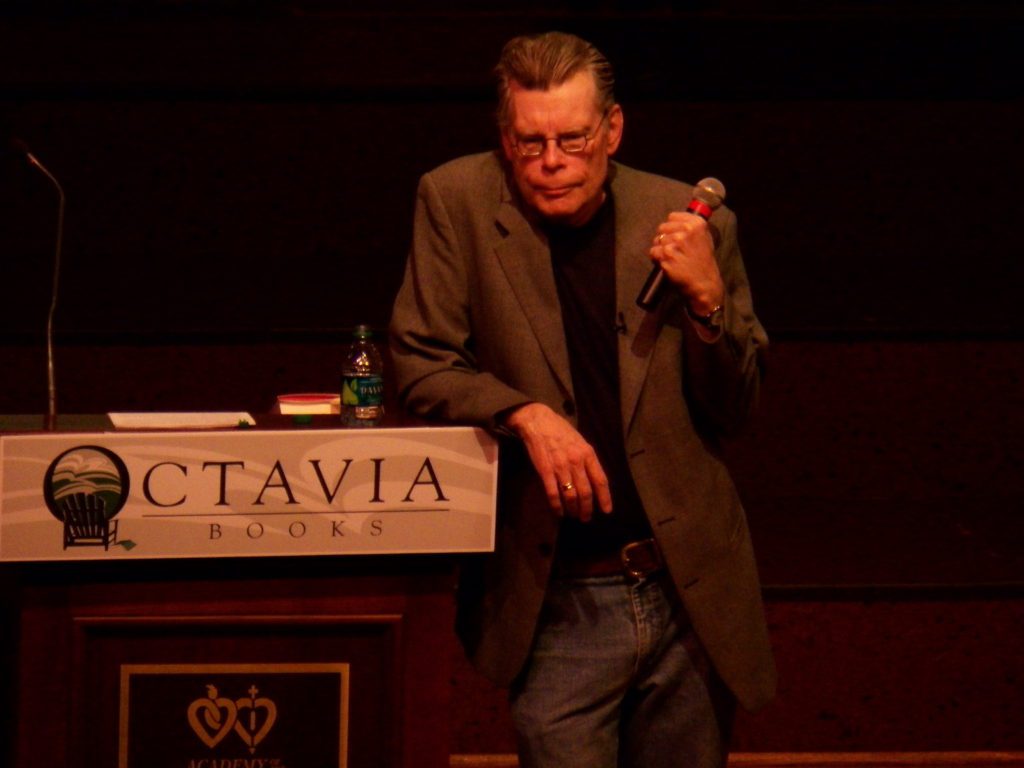Stephen King’s Top 13 Writing Tips
This past year I’ve been devouring advice books from fellow writers.
By far, the best writing advice I’ve found is Stephen King’s book On Writing. King shares stories that shaped his writing career while offering practical advice for writers and other creative professionals.
Below are the top thirteen lessons I learned from that book.
1. Use failure as fuel.
“By the time I was fourteen (and shaving twice a week whether I needed to or not) the nail in my wall would no longer support the weight of rejection slips impaled upon it. I replaced the nail with a spike and went on writing.” -Stephen King
King put a nail in his wall on which to hang rejection slips from publishers. Each rejection slip was a reminder that he was closer to his breakthrough.
Every one of us faces failure. Each failure is a critical juncture that forks the road into two paths: resignation or perseverance.
Most people won’t continue pushing past their first failure.
However, we should be thankful for failure because it thins out the herd. The strong survive; they benefit from failure’s natural selection because they choose perseverance and push beyond barriers.
2. Remove everything that is not part of the story.
“When you write a story, you’re telling yourself the story. When you rewrite, your main job is taking out all the things that are not the story.” -John Gould’s advice to Stephen King
I get “shiny thing syndrome” when I write. I begin with a single topic in mind that morphs into other concepts. Then I convince myself that those other topics are similar enough to shove into the story, so I jam them in where they don’t belong.
This isn’t just a problem in the world of writing. It happens frequently in business too. Product managers even have a word for it: “feature creep.”
You set out with a defined set of requirements for what a new software feature needs to do, but then you add more features as you go. The end result is a Frankenproduct that contains a mishmash of random features.
We can avoid “feature creep” in our writing by eliminating everything that doesn’t drive the main narrative forward in a meaningful way.
3. “Write with the door closed. Rewrite with the door open.”
“Your stuff starts out being just for you, in other words, but then it goes out. Once you know what the story is and get it right — as right as you can, anyway — it belongs to anyone who wants to read it.” -Stephen King
I’m frequently tempted to show my half-baked stories to friends. Especially when I’m excited about something, it’s hard to resist sharing it with the world. But then I remember King’s wise advice: “Write with the door closed.”
To me, that quote means I need to put in the hard work to produce something before I go around raving about it. Talking is too easy.
“Talk depletes us. Talking and doing fight for the same resources.” -Ryan Holiday
Only after I’ve finished my first draft do I allow myself to show it to others to gather their feedback.
4. Don’t dress up your vocabulary.
“One of the really bad things you can do to your writing is to dress up the vocabulary, looking for long words because you’re maybe a little bit ashamed of your short ones. This is like dressing up a household pet in evening clothes. The pet is embarrassed and the person who committed this act of premeditated cuteness should be even more embarrassed.” -Stephen King
Sometimes the first thing I write comes out stuffy and unrelatable. I try too hard and force what I’m trying to say rather than writing in a natural style.
When I catch myself puking professional-sounding text on the page, I stop and think about how I would talk about the concept in real life.
Ridiculous phrases like “my pernicious desire to sound erudite” are converted to “I wanted to sound smart.”
Many of the smartest people I know don’t go around saying big words. They instead use short words in powerful ways. We should do the same.
5. Avoid adverbs.
“I believe the road to hell is paved with adverbs, and I will shout it from the rooftops. To put it another way, they’re like dandelions. If you have one on your lawn, it looks pretty and unique. If you fail to root it out, however, you find five the next day…fifty the day after that…and then, my brothers and sisters, your lawn is totally, completely, and profligately covered with dandelions. By then you see them for the weeds they really are, but by then it’s — GASP!! — too late.” -Stephen King
King’s humorous rant against adverbs helped me realize that I not only use adverbs too often, but I often use them in ways that distract from what I’m trying to say.
For example, what sounds more persuasive: “I believe you” or “I totally believe you”?
Someone reading the phrase “I totally believe you” may wonder if we’re being sarcastic. Or they may wonder why we felt the need to imply that standard belief was not enough.
Adverbs aren’t always evil, but we should only use them when they add necessary clarity.
6. Paragraphs are maps of intent.
“You can tell without even reading if the book you’ve chosen is apt to be easy or hard, right? Easy books contain lots of short paragraphs — including dialogue paragraphs which may only be a word or two long — and lots of white space…Paragraphs are almost as important for how they look as for what they say; they are maps of intent.” -Stephen King
This principle is especially true with online writing. Short paragraphs, bullet points, large headers, and block quotes signal to skim-readers that our work is worth a deeper plunge.
Short paragraphs say, “Come on in, the water’s fine!”
7. Truthful writing often upsets people.
“If you intend to write as truthfully as you can, your days as a member of polite society are numbered.” -Stephen King
The best writing is raw and personal. Readers want real stories from real people.
Real stories mean that we will be writing about real-life events — events that involve other people who may be happy, sad, or frustrated about something that happened in the story.
For example, I’ve written about people I’ve fired, people I’ve turned down for jobs, and people I’ve micromanaged. And those are just my work-related stories.
It’s likely that some of those people aren’t happy about being featured in these stories — even when I’ve changed the names of the people in the story.
Telling the truth is necessary, but it is difficult. Don’t expect everyone to be happy about what you have written.
8. There is a timeless connection between reading and writing.
“If you want to be a writer, you must do two things above all others: read a lot and write a lot. There’s no way around these two things that I’m aware of, no shortcut.” -Stephen King
Feeling a bit weak in the writing department? Hit the gym by bench-pressing some Hemingway, Dickens, Gladwell, and Atwood. Their work will help you get into peak writing shape.
Reading good writing helps you exercise your writing muscles.
Stephen King says you can learn from bad writing as well: “Every book you pick up has its own lesson or lessons, and quite often the bad books have more to teach than the good ones.”
If you want to write, you need to read.
9. The best stories are unearthed — not created.
“Stories are relics, part of an undiscovered pre-existing world. The writer’s job is to use the tools in his or her toolbox to get as much of each one out of the ground intact as possible.” -Stephen King
King describes his writing process as “watching” his characters and writing down what they do. He says he’s often surprised by the choices they make.
He is simply the person narrating the story.
King’s process is reminiscent of Michelangelo, who famously said that his statues were already inside the stone. It was his job to chip away anything that didn’t belong to reveal the statue.
“Every block of stone has a statue inside it and it is the task of the sculptor to discover it.” -Michelangelo
Michelangelo’s process of “setting the sculptures free” inside each stone is best seen in his “Prisoners” statues, one of which is depicted below.
As writers, it is our job to unearth the story we need to tell. For fiction writers, that process entails getting inside the minds of our characters to let them tell the story. For nonfiction writers, it means finding the story hidden within every life event, every struggle, and every success we experience.
10. After the first draft, crystallize the point of your story.
“When you write a book, you spend day after day scanning and identifying the trees. When you’re done, you have to step back and look at the forest…[I]t seems to me that every book — at least every one worth reading — is about something. Your job during or just after the first draft is to decide what something or somethings yours is about. Your job in the second draft — one of them, anyway — is to make that something even more clear. This may necessitate some big changes and revisions. The benefits to you and your reader will be clearer focus and a more unified story. It hardly ever fails.” -Stephen King
King doesn’t believe in plotting stories, so his stories take him to unexpected places. After he’s finished his first draft, he looks back upon what he has created to discern the point he’s trying to convey.
This is fundamentally different than how most of us think about writing. We think we need to map out exactly where we’re going. We fall prey to the advice, “Start with the end in mind.”
King encourages us to break that model and see where the wind takes us. After all, sometimes the only way to discover what we want to say is to begin saying it.
11. 2nd draft = 1st draft — 10%
“You need to revise for length. Formula: 2nd Draft = 1st Draft — 10%.” -Editor, writing to Stephen King
Editing is a process of addition by subtraction.
Every time I re-read my work, I discover superfluous content. Here are some of my common mistakes:
- “In order to” → “To”
- “For the purpose of” → “To”
- “On a daily basis” → “Daily”
Omit needless words and find substitutes for long phrases. Your readers will thank you.
12. Identify your ideal reader.
“I think that every novelist has a single ideal reader; that at various points during the composition of a story, the writer is thinking, ‘I wonder what he/she will think when he/she reads this part?’” -Stephen King
King’s ideal reader (whom he also refers to as his “first reader”) is his wife Tabitha. He writes with her in mind and seeks her early feedback on books.
Picturing our ideal reader makes our writing more accessible and practical. I’ve used this strategy with past stories to great effect.
Generally, if a story will resonate with your ideal reader, it will resonate with hundreds of other people too.
13. Strive to write every day.
“I like to get ten pages a day, which amounts to 2,000 words. That’s 180,000 words over a three-month span, a goodish length for a book.” -Stephen King
Every strong writer has a defined writing process. King’s process is to write in the morning. He spends his afternoons napping and writing letters, then reads and hangs out with family in the evening.
I do all of my writing at night after my wife and the city are asleep. Only then am I able to fully concentrate on my work.
The time of day doesn’t matter. What does matter is making time to write. King suggests that new writers strive for writing 1,000 words per day, then build up from there.
If you haven’t read On Writing yet, I strongly urge you to do so. It’s well worth the time. Until then, I hope you’ve enjoyed this digestible summary.
Happy writing!
Want to become a stronger leader?
Sign up to get my exclusive
10-page guide for leaders and learners.









